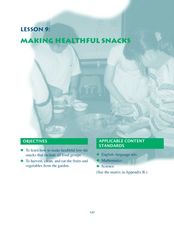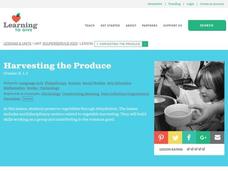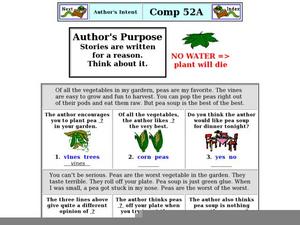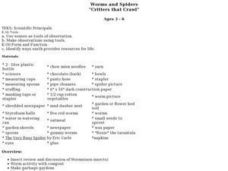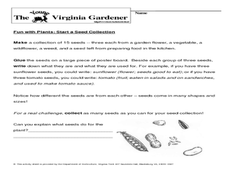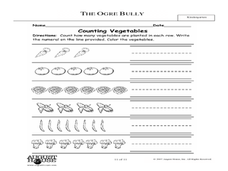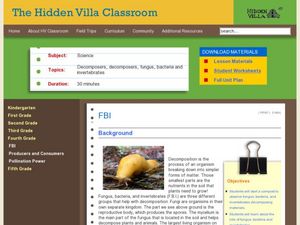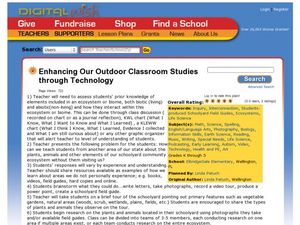Curated OER
4th Grade Food Safety Lesson
From a high-speed hand-washing lesson to identifying important nutrients in fruits and veggies, this resource has several activity ideas and worksheets for teaching food safety to your learners.
Curated OER
Grow Your Own
Students study the growth and care of plants. They take tour of their school site and plant seeds to observe their growth. Afterward, they answer questions about the origin and value of their plants.
Curated OER
A Garden in the Mailbox
Learners study seed catalogs to find information about plants and growing seasons. They write letters requesting a seed catalog after using online resources. They use them complete an associated worksheet and discuss zone maps for their...
Curated OER
Making Healthful Snacks
Students examine how to make healthy snacks that include all the food groups and how to harvest, clean and eat fruits and veggies from the garden. In this healthy snack lesson students complete several activities that have to do with...
Curated OER
Harvesting the Produce
Students investigate vegetables. In this multi-subject instructional activity, students learn about vegetables and participate in several activities using vegetables. A list of 7 materials is included.
Curated OER
Author's Intent
In this author's intent worksheet, students read two short stories about vegetables. Students answer 9 short answer questions about the author's intent or purpose.
Curated OER
Worms and Spiders: "Critters That Crawl"
Students complete a unit of lessons on spiders and worms. They discuss worm and spider characteristics, create a garbage garden, observe worms, create gummy worm prints, read the book, 'The Very Busy Spider,' and construct a spider and...
Alabama Learning Exchange
Where is the Dirt? A Lesson in Hydroponics
Students use the Internet to research hydroponic gardening which is the growing of plants without soil. They participate in an experiment where a hydroponic garden is contructed in the classroom for observaion. They recorde information...
Curated OER
Start A Seed Collection
For this start a seed collection worksheet, students collect, label and display 15 seeds 3 each from a garden flower, a vegetable, a wildflower, a weed and the kitchen, and observe the differences.
Curated OER
What Parts Are There to a Plant?
Learners explore botany by completing plant science worksheets. In this plant anatomy lesson, students examine real vegetables in class using magnifying glasses. Learners identify the plants anatomy and complete worksheets discussing...
Curated OER
The Ogre Bully Lesson
Students investigate bullies, agriculture and cooking by completing worksheets about a book they read. In this story analysis activity, students read the story The Ogre Bully, and discuss bullying as well as farming with their...
Curated OER
Using Sterile Techniques as a Tool in Studying Plant Diseases
Seventh graders examine the concept of sterile techniques. They realize that plant diseases can be identified and classified in various way. Students identify some of the diseases that attack the garden plants.
Curated OER
Dishing the Dirt Part 1
Students create a soil center on their school grounds. They begin to write in their science journals. They participate in an experiment that helps the community begin their own gardens.
Curated OER
Houses in Japan
First graders compare the everday lives of school-aged children in the United States and Japan by comparing the houses they live in. They discuss how traditional Japanese houses are designed with a feeling of opennes to the outdoors and...
Curated OER
Lets Think About...Plants
Students bring in various vegetables and make friendship soup. They plant seeds and discuss the things plants need to grow and thrive.
Curated OER
FBI
Fourth graders experiment with compost. In this Science lesson, 4th graders begin a worm compost as well as an outdoor compost. Students discuss decomposition.
Wild BC
Climate Change Bingo
Here is a 20-box bingo card to use when exploring ways that humans impact the environment. Various environmentally aware activities are listed in the boxes, and learners circulate the room to find someone who practices the different...
Curated OER
Enhancing Our Outdoor Classroom Studies through Technology
Combine science, math, and more using this resource. Learners use technology to share video and other information about their community with people throughout the state. They learn about the environment, identifying native plants, record...
EngageNY
Mid-Module Assessment Task: Grade 6 Math Module 4
Halfway through the module — the perfect time for an assessment. The 18th installment of a 36-part series is a mid-module assessment. Scholars provide evidence of understanding through various mathematical and contextual problems.
Curated OER
If the Forests Could TAlk
Third graders research insects using the internet sites provided. They research the role of insects as pollinators for plants, and the impact they have on our ecosystem. They participate in various activities/centers utilizing the facts...
Southern Nevada Regional Professional Development Program
Pardon Me, Your Modifier is Dangling
Lost! (or misplaced) a modifier. Last seen dangling at the end of a sentence! Reward offered! To underscore the humor, class members are each given a sample sentence to illustrate (A woman passed by, leading a Springer Spaniel, in a long...
Curated OER
Versailles: Home of the
Tour the grounds of the Versailles palace in this bright and vivid series of pictures. Intended to supplement a lecture on Louis XIV and the years preceding the French Revolution, these images will set a strong context for the enormous...
Disney
Earth Day Guide to Being Green
Have fun completing Earth Day related activities while learning about simple ways to preserve the Earth. Implement some of the ideas for going green as a class, like cleaning up a local park or planting a tree at school.
Curated OER
Distances on Coordinate Grids
In this grid instructional activity, 5th graders use a grid map with coordinate points to answer six questions regarding distance between locations.





